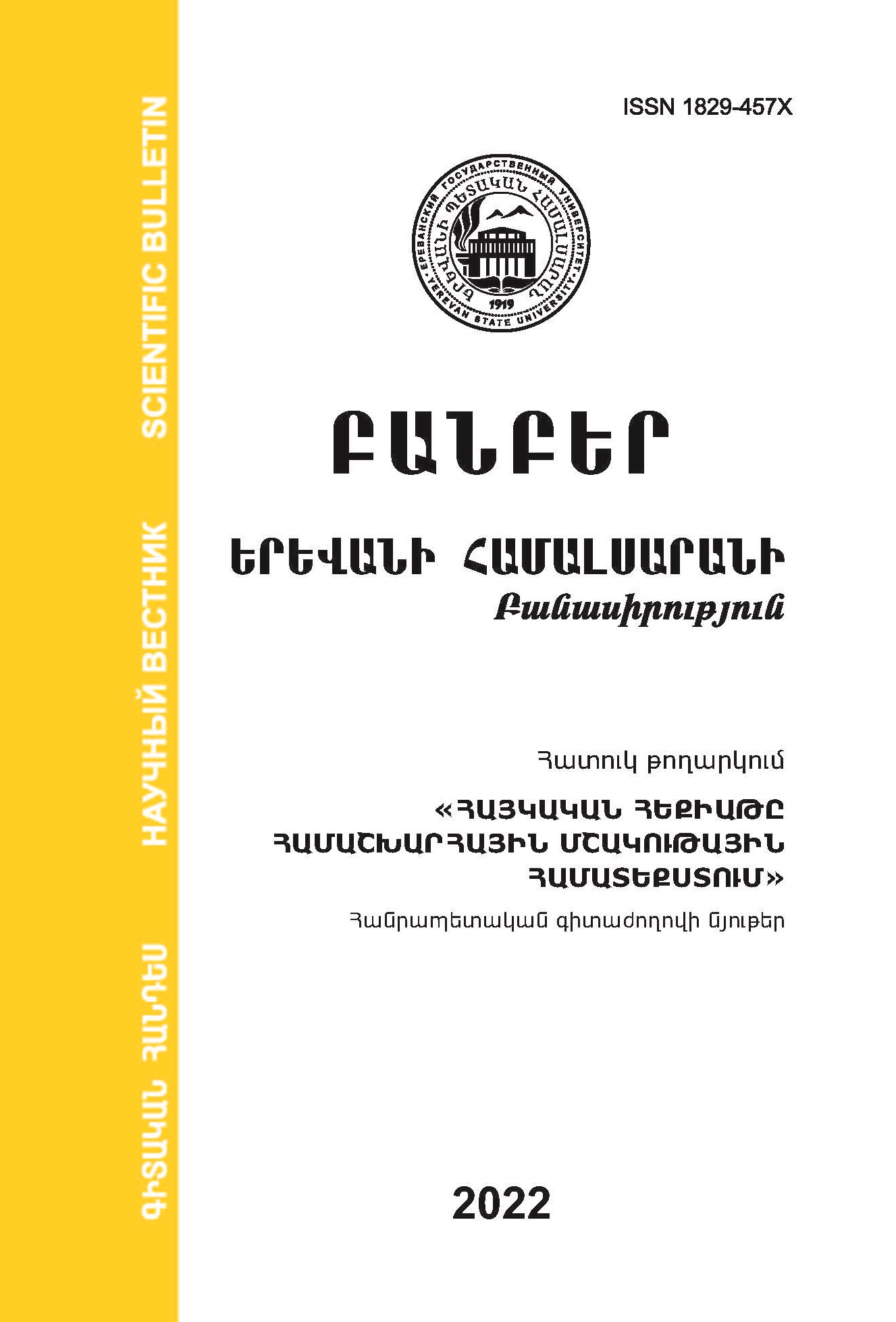Reflection of the Sea-Born Horse’s Mythologem in the Armenian Fairy-Tales and Epic
DOI:
https://doi.org/10.46991/BYSU:B/2022.sp1.003Keywords:
see, horse, sun, down, sunset, twinse, foremotherAbstract
Since ancient times, the sea and water were considered as symbols of the origin and permanence of life, therefore according to popular beliefs a marine/aquatic origin was attributed to many mythical animals and beings. In this sense, mythical steeds were not an exception. In this paper we try to explore, through the data of Armenian epic folklore, the sea-born mythical steed’s motif, in which the worships of the sun, horse, and water/sea are interwoven. While in some epic genres of folklore it is expressed as a motif, from the point of view of comparative mythology it can be studied as an archaic mythologem, which’s antiquity reaches at least as far back as the domestication of the wild horse.
References
В. В. Иванов, Конь // Мифы народов мира (энциклопедия), т. 2, М., Издательство «Советская эн-циклопедия», 1992, էջ 666: Հնդեվրոպական հասարակությունում ձիու ունեցած դերի մասին տե՛ս E. P. Hamp, The Indo-European Horse // Wien Worlds collide: indo-Europeans and Pre-Indo-European (ed. T. L. Markey and J. Greppin), Ann Arbor, Caroma Publishers, 1990, էջ 211-226; D. Anthony, Horse, Wagon and Chariot: Indo-European Languages and Archaeology // Antiquity, 69, 1995, էջ 554-565; D.Q. Adams, J. P. Malory, D. A. Miller, Horse // Encyclopedia of Indo-European Culture, London-Chicago, Fitzroy Dearborn Publishers, 1997, էջ 273-279։
Տ. Ս. Դալալյան, Վաղ թյուրքական երկու դիցանուն հայ մատենագիրների երկերում // Orientalia, 1, ԵՊՀ արևելագիտության ֆակուլտետ, Եր., 2003, էջ 74-76; Տ. Ս. Դալալյան, Շիրուան տեղանուան ստուգաբանութեան շուրջ // Հայկազեան հայագիտական հանդէս, Պէյրութ, 2006, հ. ԻԶ, էջ 23-24։
Ս. Գ. Հմայակյան, Վանի թագավորության պետական կրոնը, Երևան, ՀԳԱ հրատ., 1990, էջ 45։
Մ. Ա. Իսրայելյան, Էրեբունի բերդ-քաղաքի պատմություն (ըստ արձանագրական և հնագիտական նյութերի), Եր., «Հայաստան», 1971, էջ 72–73։
Հերոդոտոս, Պատմություն ինը գրքից (թարգմ. Ս. Կրկյաշարյան), Եր., ՀՍՍՀ ԳԱ հրատ., 1986, 88 (I, 216)։
Քսենոփոն, Անաբասիս (թարգմ. Ս. Կրկյաշարյան), Երևան, ՀԽՍՀ ԳԱ հրատ., 1970, էջ 98 (IV, 34)։
Страбон, География в 17 книгах, М., «Наука», 1964, IX, 14, 9.
Գ. Սրվանձտյանց, Երկեր, հ. 1, Եր., ՀՍՍՀ ԳԱ հրատ., 1978, էջ 76. «Վարագայ լեռը, որոյ գագաթին վրայ ելլողը կը տեսնայ եղեր, թէ ի՛նչպէս արևը վերջնալոյսին կը մտնէ ծովը, կը լողանայ, մաքրուելու և հանգչելու ըրած ուղևորութենէն»։
Հ. Ղ. Ալիշան, Հին հաւատք կամ հեթանոսական կրօնք հայոց, Վենետիկ, 1895, էջ 89, ծան. 3։
Նույն տեղում, էջ 88-89։
Բ. Ե. Թումանյան, Հ. Հ. Մնացականյան, Բրոնզե դարի գոտի-օրացույց, Եր., «Միտք», 1965, էջ 29–30։
Հ. Հ. Մնացականյան, Արևապաշտության հետքերը հին Հայաստանում ըստ բրոնզե պեղածո իրերի // Աշխատություններ ՀՍՍՌ ԳԱ պետական պատմական թանգարանի, հ. 1, Եր., ՀՍՍՌ ԳԱ հրատ., 1948, էջ 74։
Downloads
Published
How to Cite
Issue
Section
License
Copyright (c) 2022 Bulletin of Yerevan University

This work is licensed under a Creative Commons Attribution-NonCommercial 4.0 International License.

